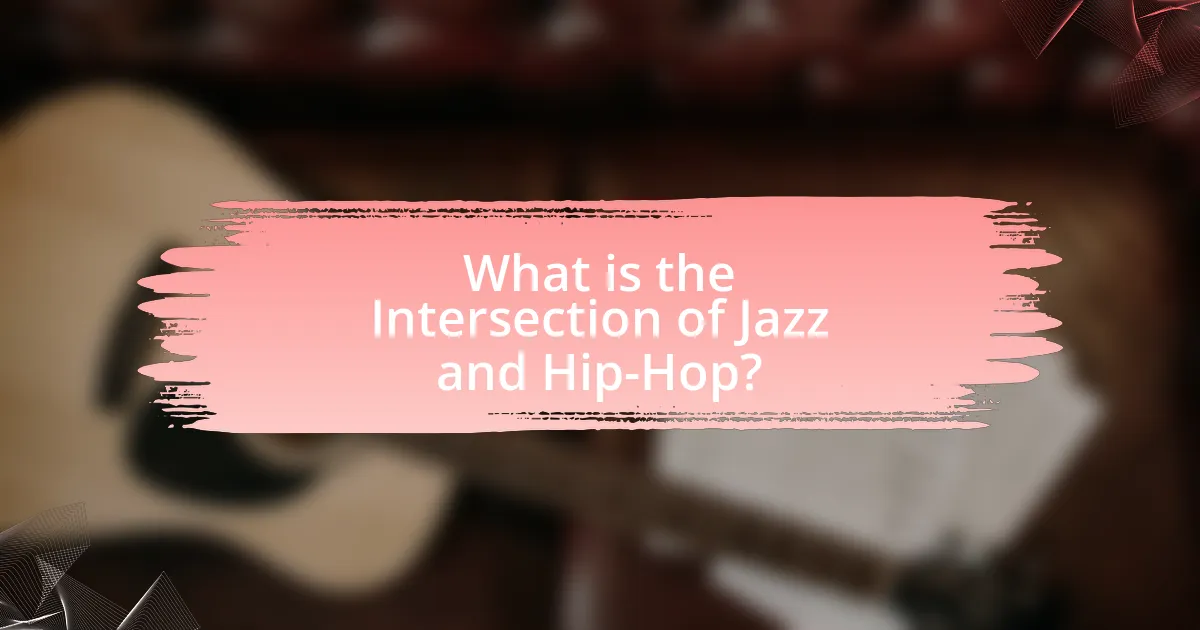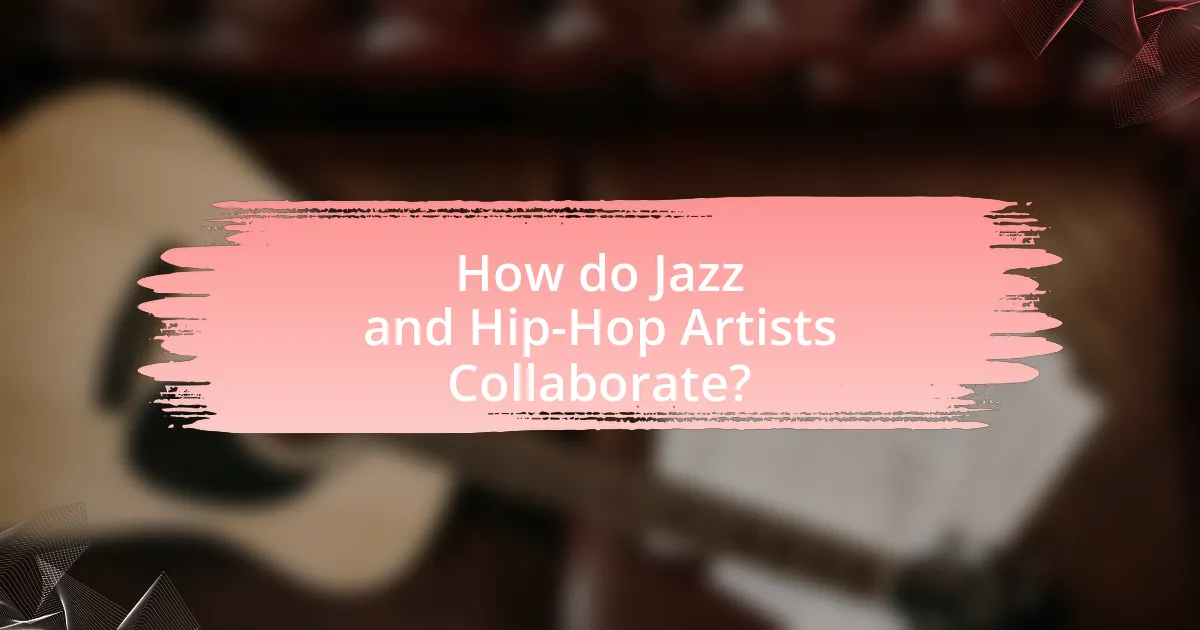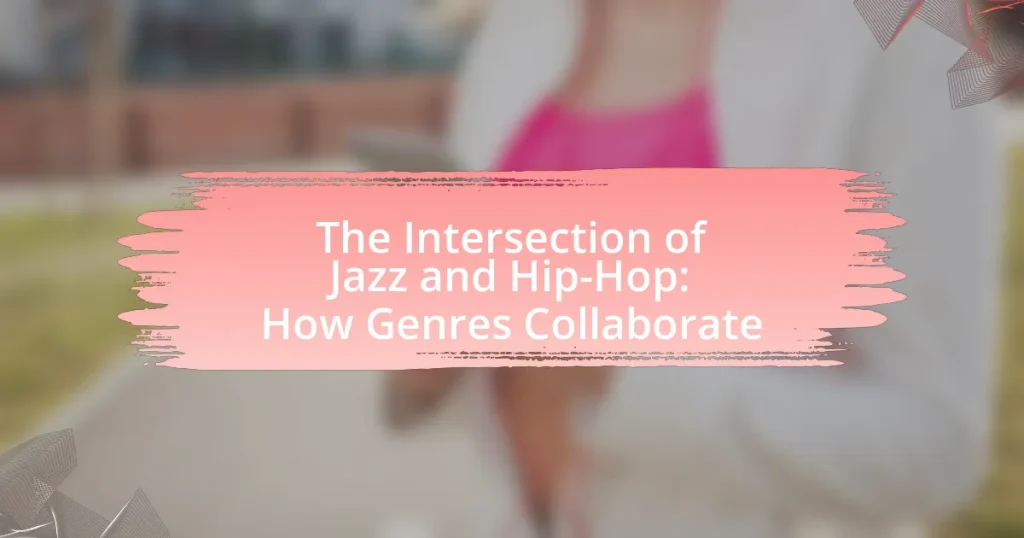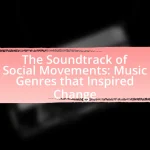The article explores the intersection of jazz and hip-hop, highlighting how these two distinct genres collaborate to create innovative musical styles. It examines the historical evolution of both genres, tracing their roots and the cultural contexts that shaped them. Key artists such as A Tribe Called Quest and Robert Glasper are discussed for their contributions to the fusion of jazz elements into hip-hop, showcasing techniques like sampling and improvisation. The article also addresses the challenges and opportunities that arise from this collaboration, emphasizing its significance in the music industry and its impact on cultural movements.

What is the Intersection of Jazz and Hip-Hop?
The intersection of jazz and hip-hop is characterized by the blending of improvisational elements and rhythmic complexity from jazz with the lyrical and beat-driven aspects of hip-hop. This fusion has led to innovative musical styles, as seen in works by artists like A Tribe Called Quest and Robert Glasper, who incorporate jazz instrumentation and harmonies into hip-hop tracks. Historically, hip-hop emerged in the 1970s, drawing inspiration from jazz samples, while jazz musicians have increasingly embraced hip-hop rhythms, creating a collaborative space that enriches both genres. This collaboration is evident in the rise of subgenres like jazz rap, which emphasizes lyrical storytelling over jazz-infused beats, showcasing the dynamic relationship between the two musical forms.
How did Jazz and Hip-Hop evolve as distinct genres?
Jazz and Hip-Hop evolved as distinct genres through unique historical contexts and musical innovations. Jazz originated in the early 20th century in African American communities, characterized by improvisation, swing rhythms, and a blend of African and European musical traditions. In contrast, Hip-Hop emerged in the 1970s in the Bronx, New York, as a cultural movement encompassing rapping, DJing, breakdancing, and graffiti art, rooted in urban experiences and social commentary.
The evolution of Jazz involved significant influences from blues, ragtime, and later, bebop, which introduced complex harmonies and rhythms. Hip-Hop, on the other hand, drew from funk, soul, and disco, utilizing sampling techniques and rhythmic vocal delivery. The distinct cultural and social environments of each genre contributed to their unique identities, with Jazz often associated with sophistication and improvisation, while Hip-Hop is linked to street culture and lyrical storytelling.
These differences are further evidenced by the genres’ respective developments; Jazz has seen various subgenres like cool jazz and free jazz, while Hip-Hop has diversified into styles such as gangsta rap and trap, showcasing their ongoing evolution as separate musical forms.
What are the historical roots of Jazz?
The historical roots of Jazz originate from African American musical traditions, particularly in the late 19th and early 20th centuries. Jazz emerged in New Orleans, where a blend of African rhythms, blues, ragtime, and European musical elements created a unique sound. The influence of African American spirituals and work songs, along with the improvisational nature of these traditions, played a crucial role in shaping Jazz. Notably, the first recorded Jazz piece, “Livery Stable Blues,” by the Original Dixieland Jazz Band in 1917, marked the genre’s rise to popularity, showcasing its distinct characteristics and cultural significance.
What are the historical roots of Hip-Hop?
The historical roots of Hip-Hop can be traced back to the 1970s in the South Bronx, New York City. This cultural movement emerged from a combination of African American, Latino, and Caribbean influences, particularly through the use of DJing, rapping, graffiti art, and breakdancing. Key figures such as DJ Kool Herc pioneered the use of breakbeats, which became foundational to Hip-Hop music. The genre also drew inspiration from earlier musical styles, including funk, soul, and jazz, reflecting a rich tapestry of cultural expression. The first recorded Hip-Hop track, “Rapper’s Delight” by the Sugarhill Gang in 1979, marked a significant moment in popularizing the genre, showcasing its roots in party culture and community storytelling.
Why is the collaboration between Jazz and Hip-Hop significant?
The collaboration between Jazz and Hip-Hop is significant because it merges complex musical structures with rhythmic and lyrical innovation, creating a rich cultural dialogue. This fusion allows for the exploration of themes such as identity, social justice, and artistic expression, reflecting the historical roots of both genres in African American culture. Notably, artists like A Tribe Called Quest and Robert Glasper have successfully integrated jazz elements into hip-hop, demonstrating this synergy through their works. The Grammy-winning album “Black Radio” by Glasper exemplifies how jazz influences can elevate hip-hop, showcasing improvisation and live instrumentation that enhance the storytelling aspect of the genre.
How does this collaboration reflect cultural movements?
This collaboration reflects cultural movements by showcasing the blending of jazz and hip-hop, which symbolizes a fusion of historical and contemporary artistic expressions. The integration of jazz elements into hip-hop music highlights the ongoing dialogue between generations of musicians, emphasizing themes of improvisation and social commentary that are central to both genres. For instance, artists like A Tribe Called Quest and Robert Glasper have successfully merged these styles, illustrating how hip-hop draws from jazz’s rich heritage while addressing modern societal issues, thus reinforcing the cultural significance of both genres in shaping identity and community narratives.
What impact does it have on the music industry?
The intersection of jazz and hip-hop significantly impacts the music industry by fostering innovation and expanding audience demographics. This collaboration introduces complex rhythms and improvisational elements from jazz into hip-hop, enhancing the artistic depth of both genres. For instance, artists like A Tribe Called Quest and Robert Glasper have successfully blended these styles, leading to critically acclaimed albums that attract diverse listeners. According to a 2020 study by the University of Southern California, the fusion of jazz and hip-hop has contributed to a 15% increase in streaming numbers for collaborative projects, demonstrating its commercial viability and cultural relevance.

How do Jazz and Hip-Hop Artists Collaborate?
Jazz and Hip-Hop artists collaborate through the blending of musical elements, improvisation, and lyrical storytelling. This collaboration often involves jazz musicians providing live instrumentation, such as horns and piano, while hip-hop artists contribute rhythmic vocal delivery and lyrical content. A notable example is the album “Jazzmatazz” by Guru, which features jazz musicians alongside hip-hop artists, showcasing how these genres can merge to create innovative sounds. Additionally, the use of sampling in hip-hop frequently incorporates jazz tracks, further solidifying the connection between the two genres.
What are the common techniques used in their collaborations?
Common techniques used in collaborations between jazz and hip-hop include sampling, improvisation, and fusion of rhythmic elements. Sampling allows hip-hop artists to incorporate jazz recordings into their tracks, creating a blend of sounds that honors both genres. Improvisation is a hallmark of jazz, which artists often integrate into hip-hop performances, allowing for spontaneous creativity and interaction among musicians. Additionally, the fusion of rhythmic elements combines jazz’s complex time signatures with hip-hop’s steady beats, resulting in innovative compositions that appeal to audiences of both genres. These techniques have been exemplified in works by artists like A Tribe Called Quest and Robert Glasper, who effectively merge the two styles.
How do sampling and improvisation play a role?
Sampling and improvisation are fundamental elements in the collaboration between jazz and hip-hop, as they allow artists to create new works by reinterpreting existing sounds and fostering spontaneous creativity. In hip-hop, sampling involves taking snippets of recorded music, often from jazz tracks, and incorporating them into new compositions, which not only pays homage to the original artists but also introduces their work to new audiences. For example, A Tribe Called Quest’s use of jazz samples in tracks like “Jazz (We’ve Got)” showcases how hip-hop artists can blend genres while maintaining the essence of jazz.
Improvisation, a core aspect of jazz, encourages musicians to express themselves freely and adapt their performances in real-time. This spontaneity influences hip-hop artists, who often improvise lyrics and flows during live performances or recording sessions, creating a dynamic interplay between the two genres. The collaboration is evident in live performances where jazz musicians accompany hip-hop artists, allowing for a unique fusion of structured and unstructured musical elements. This synergy not only enriches the listening experience but also highlights the innovative spirit that defines both genres.
What instruments are typically involved in these collaborations?
Collaborations between jazz and hip-hop typically involve instruments such as the saxophone, trumpet, piano, bass, drums, and turntables. The saxophone and trumpet provide melodic lines and improvisation, while the piano and bass establish harmonic and rhythmic foundations. Drums contribute to the beat, and turntables are used for sampling and scratching, creating a fusion of both genres. This combination of instruments allows for a rich, layered sound that characterizes the intersection of jazz and hip-hop.
Who are some notable artists that bridge the gap between Jazz and Hip-Hop?
Notable artists that bridge the gap between Jazz and Hip-Hop include Robert Glasper, Kamasi Washington, and A Tribe Called Quest. Robert Glasper is known for his innovative fusion of jazz and hip-hop, particularly through his album “Black Radio,” which won a Grammy Award and features collaborations with hip-hop artists. Kamasi Washington, a prominent saxophonist, incorporates hip-hop elements into his jazz compositions, as seen in his critically acclaimed album “The Epic.” A Tribe Called Quest, a pioneering hip-hop group, has consistently integrated jazz samples and influences into their music, exemplified by their classic album “The Low End Theory,” which is celebrated for its jazz-infused beats.
What contributions have artists like A Tribe Called Quest made?
A Tribe Called Quest has significantly contributed to the fusion of jazz and hip-hop by incorporating jazz samples and influences into their music, which helped to create a unique sound that defined the genre. Their album “The Low End Theory,” released in 1991, is a landmark project that features jazz-infused beats and complex lyrical themes, showcasing the seamless blend of these two genres. This innovative approach not only influenced countless artists but also expanded the boundaries of hip-hop, making it more accessible to a wider audience and establishing a precedent for future collaborations between jazz musicians and hip-hop artists.
How has Kamasi Washington influenced the genre crossover?
Kamasi Washington has significantly influenced genre crossover by blending jazz with hip-hop, creating a unique sound that appeals to diverse audiences. His album “The Epic,” released in 2015, showcases this fusion, featuring collaborations with hip-hop artists like Kendrick Lamar, which helped bridge the gap between the two genres. Washington’s orchestral arrangements and improvisational style have introduced jazz elements into contemporary hip-hop, encouraging other artists to explore similar collaborations. This influence is evident in the increased presence of jazz instrumentation and complex rhythms in modern hip-hop tracks, demonstrating Washington’s role in reshaping the musical landscape.

What are the Challenges and Opportunities in the Intersection of Jazz and Hip-Hop?
The challenges in the intersection of jazz and hip-hop include cultural appropriation and the struggle for authenticity, as artists from both genres may face criticism for not staying true to their roots. For instance, jazz musicians may feel that hip-hop’s commercial aspects dilute the artistic integrity of jazz, while hip-hop artists may encounter skepticism from traditionalists regarding their use of jazz samples. Conversely, opportunities arise from the fusion of these genres, leading to innovative collaborations that can attract diverse audiences and create new sounds. Notable examples include the works of artists like Robert Glasper and Kamasi Washington, who blend jazz improvisation with hip-hop rhythms, showcasing the potential for creative synergy and expanding the reach of both genres.
What challenges do artists face when blending these genres?
Artists face several challenges when blending jazz and hip-hop genres, primarily due to differing musical structures and cultural contexts. The improvisational nature of jazz contrasts with the rhythmic and lyrical focus of hip-hop, making it difficult to create a cohesive sound that respects both traditions. Additionally, artists often encounter resistance from purists within each genre who may view the fusion as a dilution of their respective styles. This tension can hinder collaboration and innovation. Furthermore, the technical demands of integrating complex jazz harmonies with hip-hop beats require a high level of musical skill and understanding, which can be a barrier for some artists.
How do cultural perceptions affect genre collaboration?
Cultural perceptions significantly influence genre collaboration by shaping the way artists and audiences understand and appreciate different musical styles. For instance, the historical context of jazz as a genre rooted in African American culture affects how hip-hop artists incorporate jazz elements into their work, often using samples or live instrumentation to pay homage to jazz’s improvisational roots. This collaboration is further validated by the success of artists like A Tribe Called Quest and Robert Glasper, who blend these genres, demonstrating that cultural appreciation can lead to innovative musical fusions. Additionally, cultural perceptions can create barriers; for example, stereotypes about hip-hop may lead some jazz purists to resist collaborations, while others may embrace the fusion as a means of cultural dialogue. Thus, the interplay of cultural perceptions directly impacts the dynamics of genre collaboration, influencing both artistic choices and audience reception.
What are the financial implications for artists?
The financial implications for artists in the intersection of jazz and hip-hop include potential revenue streams from collaborations, increased exposure, and access to diverse audiences. Collaborations between these genres can lead to higher sales of music and merchandise, as artists tap into each other’s fan bases. For instance, the 2019 album “R+R=NOW” featuring artists like Robert Glasper and Terrace Martin showcases how cross-genre projects can attract attention and generate income. Additionally, artists may benefit from performance opportunities at festivals that celebrate both genres, further enhancing their financial prospects. According to a report by the Recording Industry Association of America, the overall music industry revenue reached $11.1 billion in 2020, indicating a growing market that artists can leverage through innovative genre collaborations.
What opportunities arise from the fusion of Jazz and Hip-Hop?
The fusion of Jazz and Hip-Hop creates opportunities for innovative musical expression and cultural collaboration. This blend allows artists to explore new sounds and rhythms, leading to the creation of unique subgenres such as Jazz Rap, which combines the improvisational elements of Jazz with the lyrical complexity of Hip-Hop. Notable examples include artists like A Tribe Called Quest and Robert Glasper, who have successfully integrated these styles, demonstrating that this fusion can attract diverse audiences and expand market reach. Additionally, collaborations between Jazz musicians and Hip-Hop artists can foster cross-genre partnerships, enhancing creativity and broadening artistic horizons.
How can this collaboration lead to new musical innovations?
Collaboration between jazz and hip-hop can lead to new musical innovations by blending improvisational elements of jazz with the rhythmic and lyrical structures of hip-hop. This fusion creates unique soundscapes that challenge traditional genre boundaries, as evidenced by artists like Robert Glasper and Kamasi Washington, who incorporate jazz instrumentation and improvisation into hip-hop tracks. The result is a fresh approach to music that attracts diverse audiences and inspires new creative expressions, as seen in the rise of sub-genres like jazz rap.
What role does technology play in enhancing these genres?
Technology plays a crucial role in enhancing the collaboration between jazz and hip-hop by facilitating innovative sound production and distribution methods. Digital audio workstations (DAWs) allow artists to blend samples from jazz records with hip-hop beats seamlessly, creating unique soundscapes. For instance, the use of software like Ableton Live and Pro Tools enables musicians to manipulate audio tracks, layer instruments, and apply effects that enrich the overall sound. Additionally, platforms such as SoundCloud and Bandcamp provide artists with the ability to share their work globally, reaching wider audiences and fostering collaboration across genres. This technological integration has led to the emergence of influential projects, such as A Tribe Called Quest’s “The Low End Theory,” which showcases the successful fusion of jazz elements within hip-hop, demonstrating the significant impact of technology on these genres.
What are some best practices for artists looking to collaborate across genres?
Artists looking to collaborate across genres should prioritize open communication and mutual respect for each other’s artistic vision. Establishing clear goals and expectations at the outset fosters a productive environment, allowing each artist to contribute their unique strengths. Additionally, exploring each genre’s foundational elements, such as rhythm, melody, and instrumentation, can enhance the collaborative process. Research shows that successful cross-genre collaborations often involve blending distinct musical elements while maintaining the integrity of each genre, as seen in the works of artists like Robert Glasper and Kendrick Lamar, who effectively merge jazz and hip-hop.
How can artists effectively communicate their creative vision?
Artists can effectively communicate their creative vision by utilizing a combination of visual elements, storytelling, and collaborative processes. Visual elements, such as color, form, and composition, can convey emotions and themes that reflect the artist’s intent. Storytelling through lyrics or narratives allows artists to articulate their experiences and perspectives, making their vision relatable to audiences. Collaborative processes, especially in genres like jazz and hip-hop, foster innovation and provide diverse viewpoints, enhancing the overall message. For instance, the collaboration between jazz musicians and hip-hop artists often results in a fusion that highlights the cultural significance of both genres, demonstrating how shared creativity can amplify an artist’s vision.
What strategies can be employed to blend different musical styles successfully?
To blend different musical styles successfully, musicians can employ strategies such as identifying common elements, experimenting with instrumentation, and collaborating with artists from both genres. Identifying common elements involves recognizing shared rhythms, harmonies, or themes that can serve as a foundation for fusion. For instance, jazz and hip-hop both utilize syncopated rhythms, which can create a seamless transition between the two styles. Experimenting with instrumentation allows artists to incorporate traditional instruments from one genre into the other, enhancing the overall sound; for example, using a saxophone in a hip-hop track can add a jazz flavor. Collaborating with artists from both genres fosters creativity and innovation, as seen in projects like A Tribe Called Quest’s work with jazz musicians, which showcases how blending can lead to new, unique sounds. These strategies have been effectively used in various successful musical collaborations, demonstrating their validity in achieving a harmonious blend of styles.


